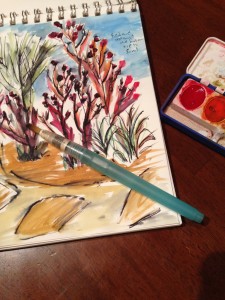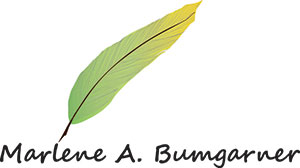Learning to Sketch
I spent last weekend learning to sketch with a parallel pen. Saturday morning had begun with a phone call and some troublesome news. My first instinct was to stay where I was and worry, something I’m very good at, as I’ve mentioned before. However, I’d already packed my water color notebook, pens, pencils, and paintboxes, and it was after eight a.m. when I got off the phone, so I decided I’d better continue on to class. I could worry there.
The sketching workshop was held in the Horticulture building of a local community college, and was at the very top of the hilly campus, with a magnificent view of the valley below. Walking from the parking lot to the classroom I passed large garden beds planted with lush grasses and colorful shrubs, and a pond surrounded by rocks and trees. Huge clumps of rushes rustled in the breeze. The wind threatened to lift the large notebook out of my arms, and it ruffled my hair. Thus my senses were awakened before we even began to draw, and any concerns that had been triggered by the phone call — well, let’s just say they were put away for a while.
Getting older has its challenges. But how we address those challenges determines how we will live the rest of our lives. We can let our aches and pains keep us from exercising, and eventually we will get stiffer and stiffer, and more and more frail. Our unreliable memory can make us seem incompetent or flaky to others, or we can organize ourselves, use a daily planner, adopt good habits of mind.
In this case, my unpleasant memory of a 7th grade art class and my very limited drawing skills could have kept me from enjoying an excursion into artistic expression, but I had decided that it was time I gave myself permission to learn something new.
Lifelong Learning
As I have written elsewhere in this space, scientific studies support the idea that participating in various types of physical and intellectual activity as we age improves our overall well-being. Reasonable physical activity can reduce the pain of arthritic joints, lower blood pressure, and decrease the likelihood of injuries. Cognitive engagement, in the form of discussion groups, cooking clubs, art and music classes, or formal classroom instruction, can help flagging memories, improve problem-solving, and some researchers even believe postpone or prevent certain types of age-related dementia.
It’s called Lifelong Learning, and while it’s a useful strategy for anyone, including those still engaged in full time careers, it’s an especially important endeavor for those of us whose lives are no longer scheduled around commutes and car pools, and who have the luxury of long stretches of unencumbered time. It’s also, I have discovered, lots of fun.
Losing Yourself in Learning
I spend a lot of my time with my granddaughter watching her learn. She puts her whole self into the process of holding a paintbrush just right, or standing on one leg, or separating an egg. Losing herself in the process of learning comes perfectly naturally to her, and I’ve been trying to follow her example.
Getting to this weekend workshop required a very clear intention on my part. I first of all waited for the semi-annual catalog of community service classes to arrive from the community college, which it did shortly after I returned from the UK in early January. I read it, cover to cover, trying to discern if my pulse raced just a little bit faster when I read a particular class description. Sketching in Yosemite appealed to me, but that seemed like a really big commitment for someone who didn’t yet know how to sketch. And Keeping an Illustrated Travel Journal also jumped off of the page. But I wasn’t planning to travel anywhere very soon. The next course listed was Sketching: Journals and Juxtaposition. I wasn’t sure what juxtaposition meant in that context (I’m still not), but I’ve always loved writing in journals, and I decided it would be fun to add some sketches to my musing. I wrote the check for $90 and mailed in my registration for the class, which wouldn’t be until July. I could always change my mind.
I did waffle a little when I saw the list of supplies we would need. It was pretty extensive, and I suspected expensive. I postponed going to the art supply store until just a few days before class. But something occurred before then which convinced me to bite the bullet, buy the supplies, and show up. My daughter invited me to visit a local arboretum with her and Bean. I envisioned us walking for an hour among the plants, talking pleasantly while Bean ran from rock to rock. Instead, shortly after we entered the Butterfly Garden, at the beginning of the trail, both mother and daughter took out their notebooks and pencils, and sat down to sketch.
I found a comfortable rock a little bit down the hill so I could watch. My daughter sketches all the time, and keeps a beautifully illustrated journal, but what was new for me was watching a four year old screwing up her face in concentration as she looked closely at the flower she was trying to draw, and working so hard to get it just right. When she complained that she couldn’t figure out how a particular flower was attached to the stem, her mother showed her how to place her fingers on either side of the stem and turn the flower slightly so she could see under it.
This scene was repeated several times that afternoon. We didn’t make it very far into the arboretum, but my attitude toward sketching underwent a sea change. If my four year old granddaughter could lose herself for an hour at a time in learning how to reproduce a flower, a leaf, a caterpillar, surely I could do the same.
Losing oneself in learning is not something most adults do. But I am gradually getting the courage to try. That day in the sketching workshop I made a good start. The time flew by as I made line after line with the parallel pen, some fat, some skinny, many with ragged edges, just a few that were solid. When we were sent ou tside to sketch something in the garden, I couldn’t believe it was already eleven o’clock. After lunch we took the sketches we had made and began to add color to them, using watercolor pencils and pens, or brushes and paint. There were twelve of us in the room, but for a long time all you could hear was the scratching of pens, the swish of brushes, the occasional murmur of satisfaction as one of us looked down at our paper and saw something we liked.
tside to sketch something in the garden, I couldn’t believe it was already eleven o’clock. After lunch we took the sketches we had made and began to add color to them, using watercolor pencils and pens, or brushes and paint. There were twelve of us in the room, but for a long time all you could hear was the scratching of pens, the swish of brushes, the occasional murmur of satisfaction as one of us looked down at our paper and saw something we liked.
I didn’t become a sketcher in that one day of class, but I learned just enough to spend some time the next day on my own trying out what I had learned. And today I signed up to join a monthly sketching group just to make sure that I don’t forget to keep learning. It felt so very very good.
Share this post





Delightful! Enjoyed your writing style and story!
I’ve signed up to get your future blogs…thanks!
Thank YOU for a lovely day of sketching!